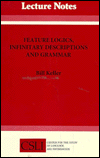Feature Logics, Infinitary Descriptions and Grammar
Constraint and unification-based approaches to grammar have become increasingly popular in computational linguistics because of their flexibility and descriptive power. These approaches have developed an important notion of feature structures that play a key role in the representation of linguistic information. This book provides a detailed survey and comparison of recent approaches to the logical formalization of feature structures and their description languages in constraint and...
Search in google:
Constraint and unification-based approaches to grammar have become increasingly popular in computational linguistics because of their flexibility and descriptive power. These approaches have developed an important notion of feature structures that play a key role in the representation of linguistic information. This book provides a detailed survey and comparison of recent approaches to the logical formalization of feature structures and their description languages in constraint and unification-based grammar formalisms. Bill Keller is a lecturer in computer science and artificial intelligence in the School of Cognitive and Computing Sciences at the University of Sussex.
Preface1Introduction11.1Outline of this Book41.2Constraint-Based Grammar Formalisms51.3Feature Structures71.4Formal Models of Feature Structures112A Survey of Feature Logics142.1A Denotational Model of Descriptions162.2Rounds-Kasper Logic212.3Category Logic422.4Attribute-Value Logic452.5Smolka's Feature Logic503Regular Rounds-Kasper Logic603.1Unbounded Dependencies613.2LFG and Functional Uncertainty653.3Regular Rounds-Kasper Logic693.4The Satisfiability Problem774Regular Rounds-Kasper Logic with Negation944.1Syntax and Semantics954.2Expressing Generalizations in NRRK974.3NRRK and Category Logic1004.4NRRK and the Satisfiability Problem1075Infinitary Descriptions and Grammars1165.1Constituent Structure1175.2Representing Grammars in NRRK1236Conclusion155Bibliography161








